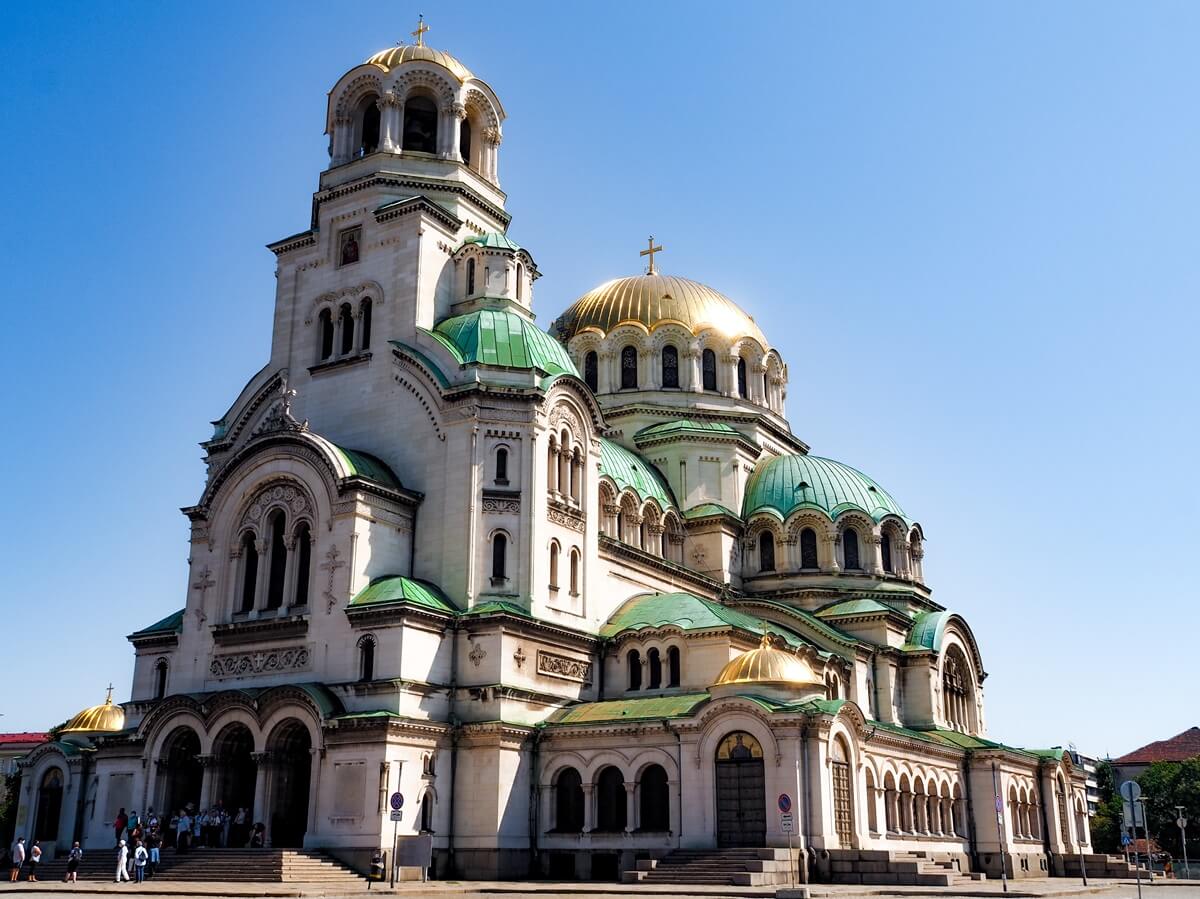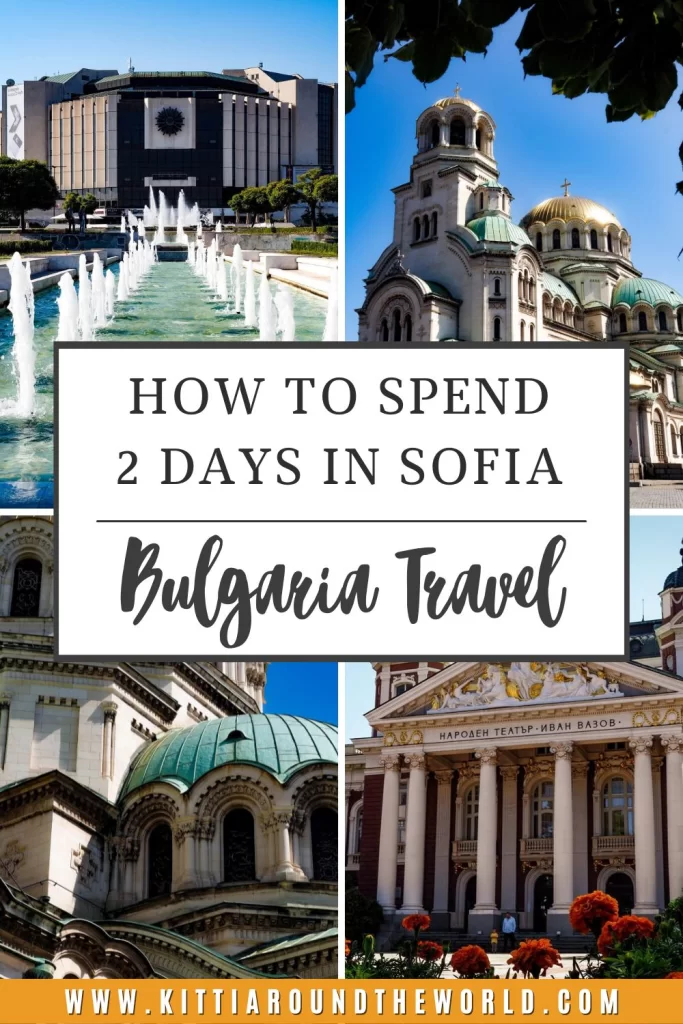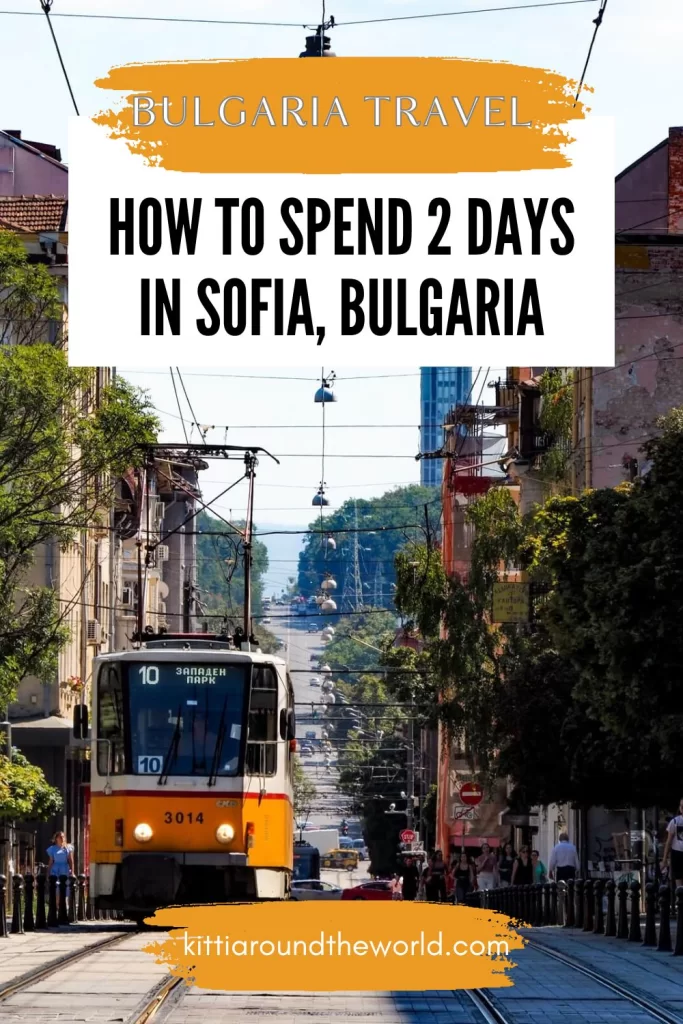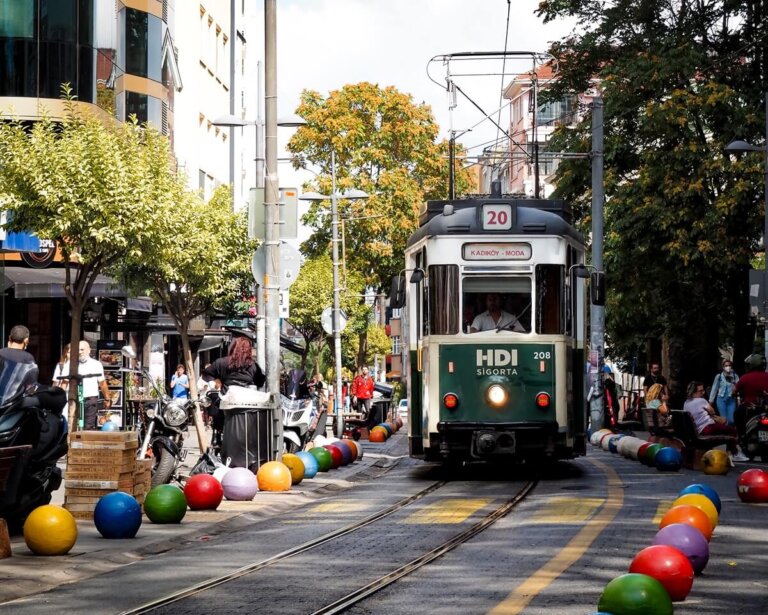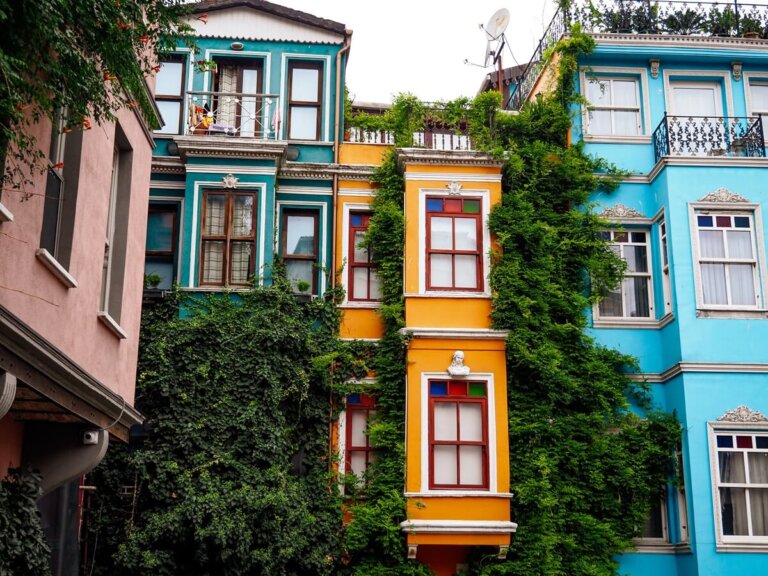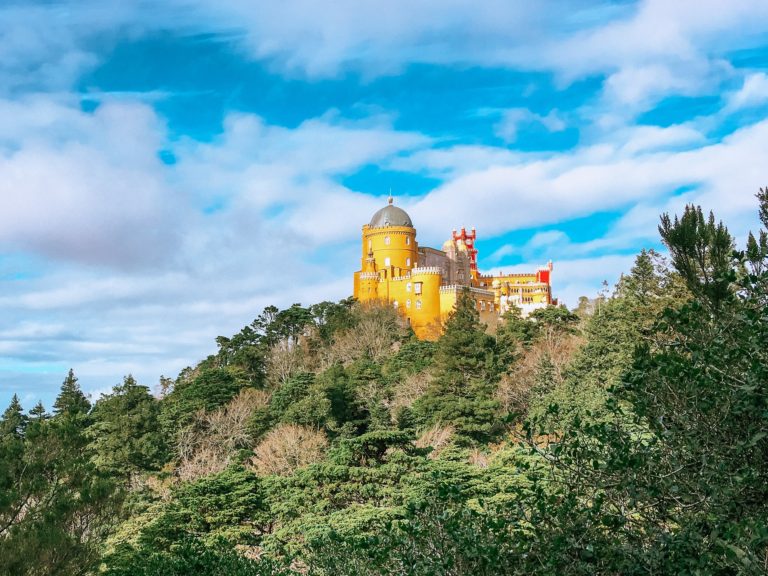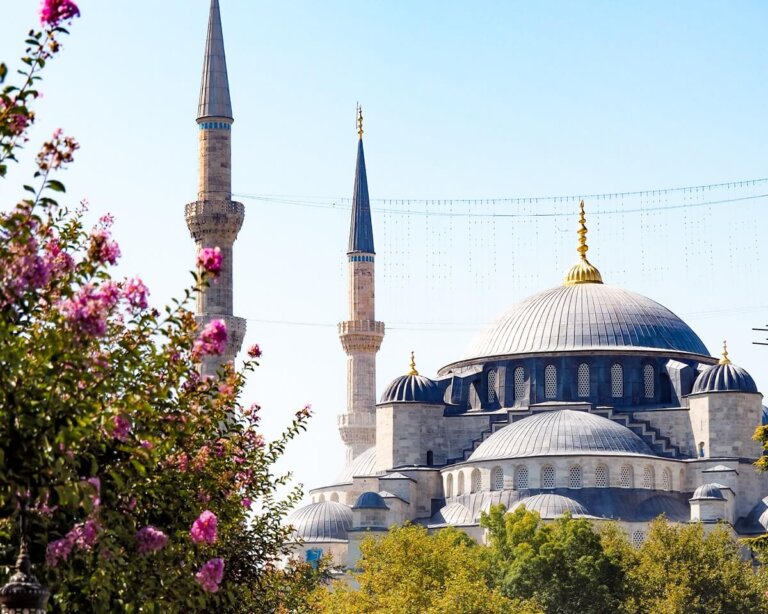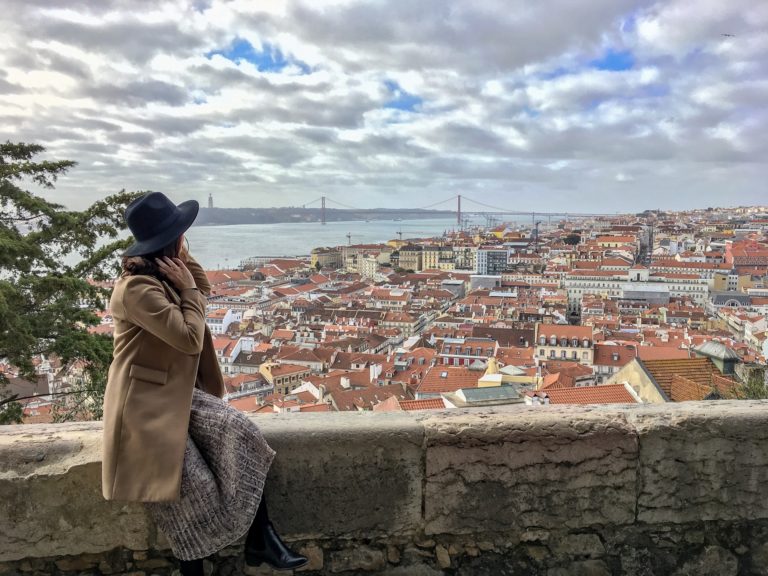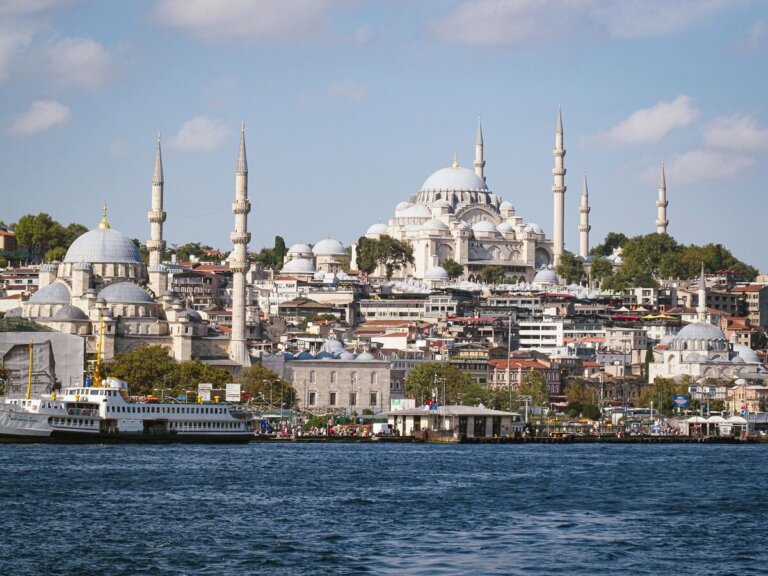How to Spend 2 Days in Sofia, Bulgaria
As one of the oldest cities in Europe, Sofia is a fantastic city break destination. In this guide you can read about how to spend 2 days in Sofia, the capital of Bulgaria. We’ve included a list of the best things to do in the city, as well as useful information on how to get there, where to stay and what to eat.
You’re probably wondering whether the Bulgarian capital is worth a visit. Whilst at first glance it might not seem like there’s an awful lot to do in the city, in reality, there’s plenty to keep you busy for a weekend.
A few of the Balkan countries, such as Greece and Croatia, have become very popular places to visit. So much so, that sometimes they suffer from over-tourism, especially in the high season. Luckily, other countries like Montenegro, Albania, and Bulgaria are still more underrated travel destinations. They’re just as beautiful, with the added bonus that you can enjoy these places without a huge influx of tourists or highly inflated prices.
Disclosure: This post may contain affiliate links, which means we may receive a small commission if you click a link and purchase something. Clicking these links won’t cost you anything, but it will help us to keep this site up and running! Learn more about our affiliate policy.

About Sofia, Bulgaria
Situated at the foot of Mount Vitosha, in the western part of Bulgaria, Sofia is the largest city in the country.
It became the capital of Bulgaria in 1879, however its history goes back thousands of years, making Sofia one of the oldest cities in Europe. We won’t go too deep into Bulgarian history, but it’s always good to highlight some of the main events that shaped the city Sofia is today.
The Bulgarian capital was originally a Thracian settlement called ‘Serdica’. Then in 29 BC, it became part of the Roman Empire. In 809 AD, during the reign of Khan Krum, Sofia was included in the First Bulgarian Empire and was called ‘Sredets’. Following many sieges, Sofia fell to the Byzantine Empire and remained under their control until the Second Bulgarian Kingdom emerged. This was also the time the city got its current name of Sofia. Quite a few churches and monasteries were constructed in this time period.
In 1385, Sofia was conquered by the Ottoman Empire and was under Ottoman rule until 1878. The Ottomans built a lot of new mosques and also converted some of the existing churches. However, during the Russo-Turkish war most of the mosques were destroyed.
Bulgaria participated in World War I on the side of the Central Powers. In 1944, the country fell under Communist rule and was a close ally of the Soviet Union until it collapsed in 1989. During this era, Sofia’s architecture adopted a Grandiose Stalinist-style. Since 1990, Bulgaria has been a parliamentary democracy. In 2004 the country became a member of NATO then, in 2007, it also joined the European Union (EU). Today, Sofia continues to be the cultural, economic, and administrative centre of Bulgaria.
Our Top Travel Resources to Visit Sofia
- ✈️ Search for flights to Madeira on Skyscanner
- 🛏️ Find your accommodations with Booking.com
- 🚗 Rent a car in Madeira with Discover Cars
- 🎫 Book an organised tour in Madeira with GetYourGuide
- 🛜 Stay connected with Holafly eSIM (get 5% off with code ‘KITTIAROUNDTHEWORLD’)
- 🛡️Don’t forget to buy travel insurance via SafetyWing
How to Spend 2 Days in Sofia, Bulgaria
Thanks to Sofia’s rich history, you’ll quickly notice that the city is home to countless religious buildings, museums, monuments and stunning architecture everywhere you look. You definitely won’t have trouble finding something to do during your time there.
The majority of the attractions we’ve listed below are located within the city centre or situated only slightly outside of it. We mainly highlighted the top sights that should definitely be on your list as a first time visitor. These are completely doable in 2 days without rushing. However, there is plenty to do in the area surrounding Sofia too, in case you’re staying in the city for a bit longer.

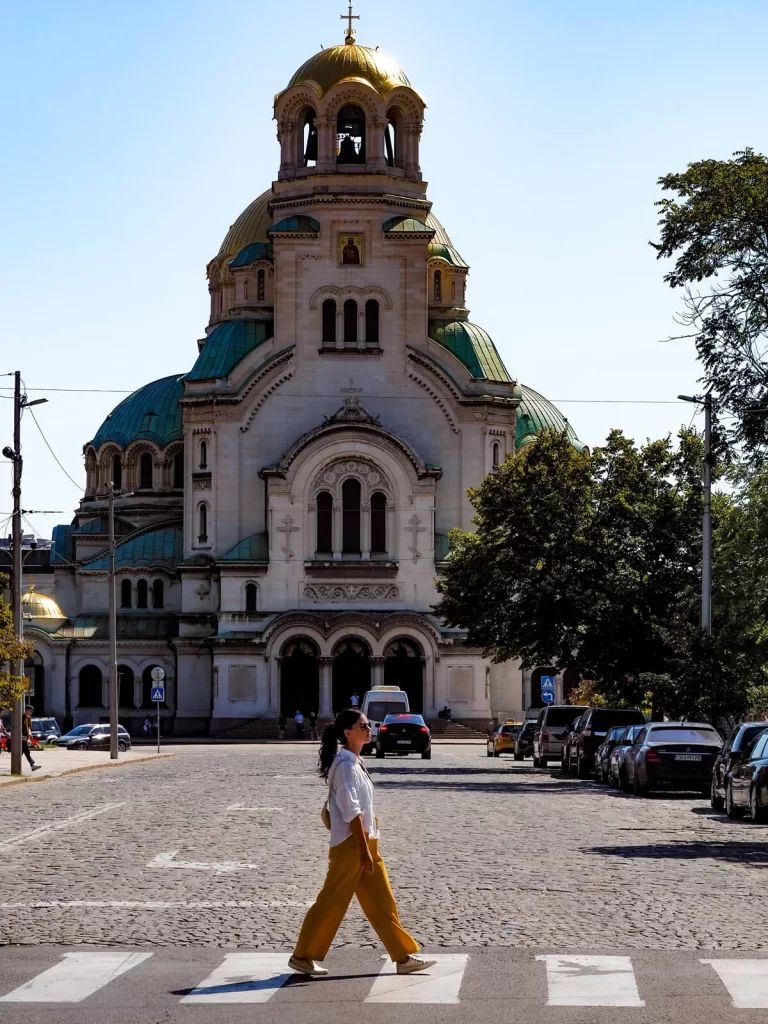
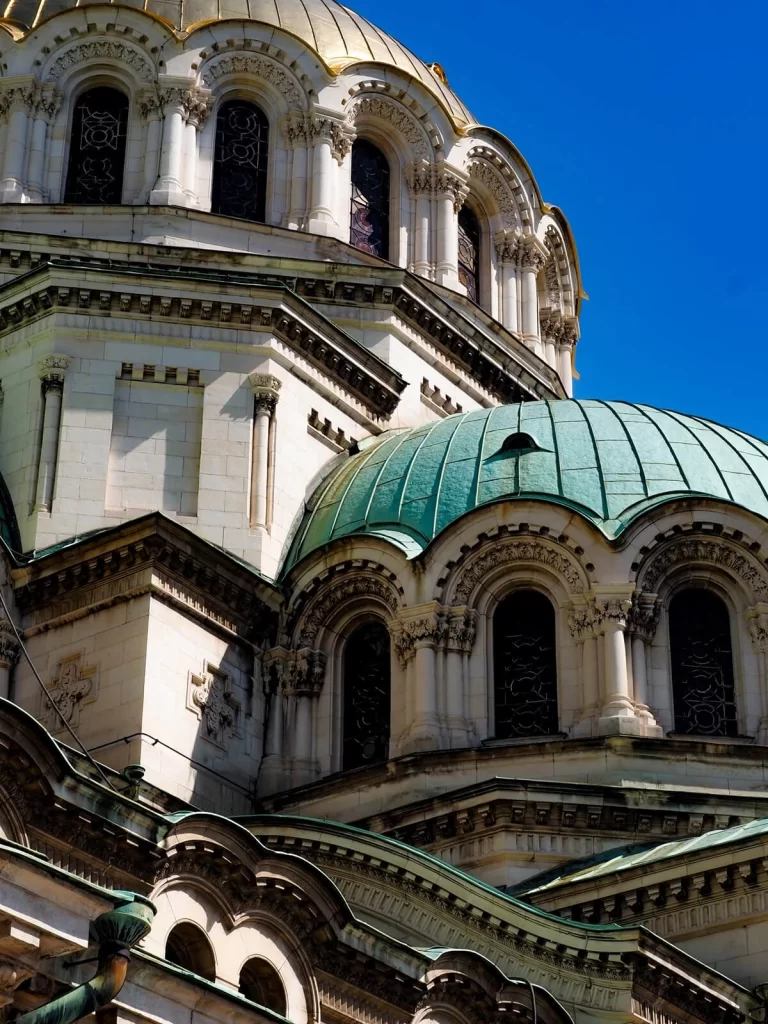
1. Visit Sofia’s Most Beautiful Religious Buildings
There are so many religious buildings in Sofia that you could easily spend 2 days checking them all out. To avoid that, we’ve only listed some of the best ones that you can easily incorporate into a long weekend without feeling overwhelmed.
Alexander Nevsky Cathedral (No.1 Attraction in Sofia)
We think it’s safe to say that every city has an iconic landmark that comes to mind when someone mentions that place. For example, if someone says Rome, surely a picture of the Colosseum would pop up into your mind first. If you think about Berlin, we bet you’re seeing a mental image of the Brandenburg Gate.
Well, when it comes to Sofia, many people would think of the Alexander Nevsky Cathedral. Even if they didn’t know the exact name of this stunning symbol of the city. So what better way to start your 2 day adventures in Sofia than to visit this huge cathedral.
It was built between 1882 and 1912 in honour of the Russian soldiers who participated in the liberation of Bulgaria from the Ottomans. Today, the cathedral is considered one of the largest Eastern Orthodox cathedrals in the world.
You can visit inside for free, but we personally didn’t find the interior as fascinating as the exterior.
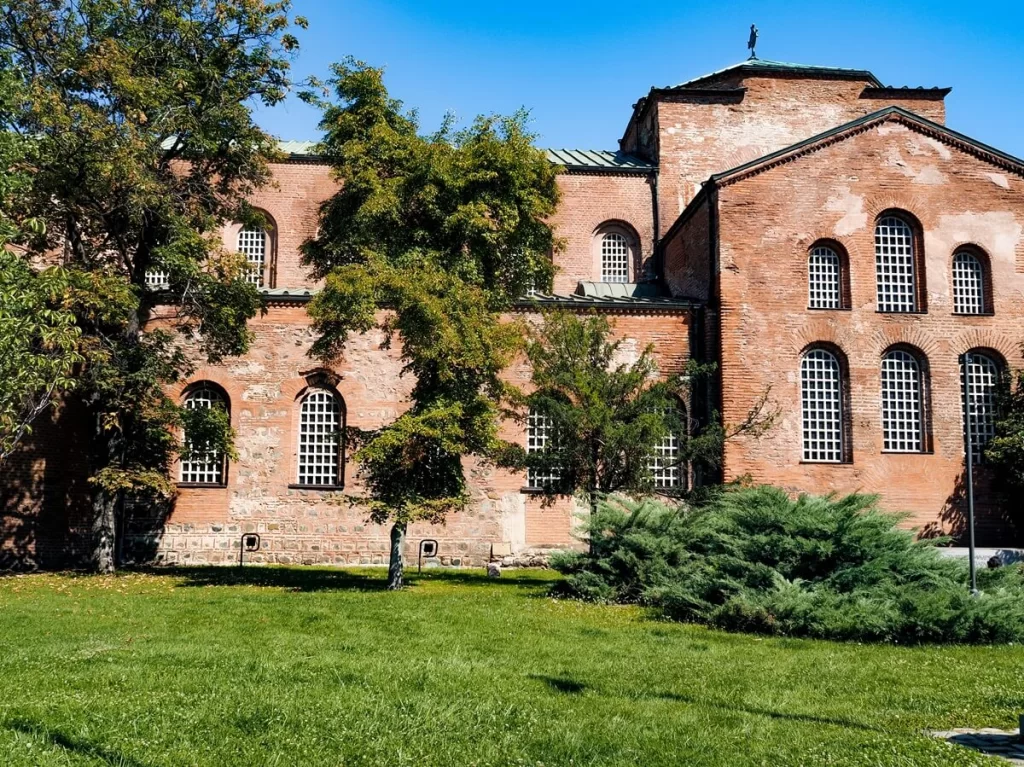
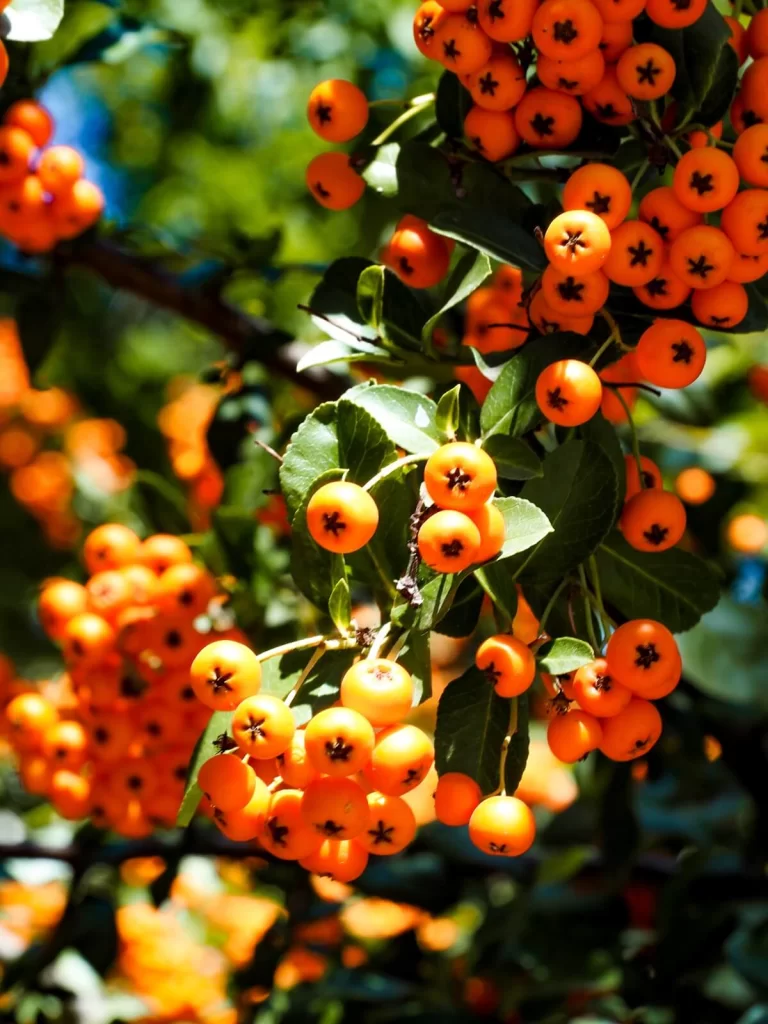
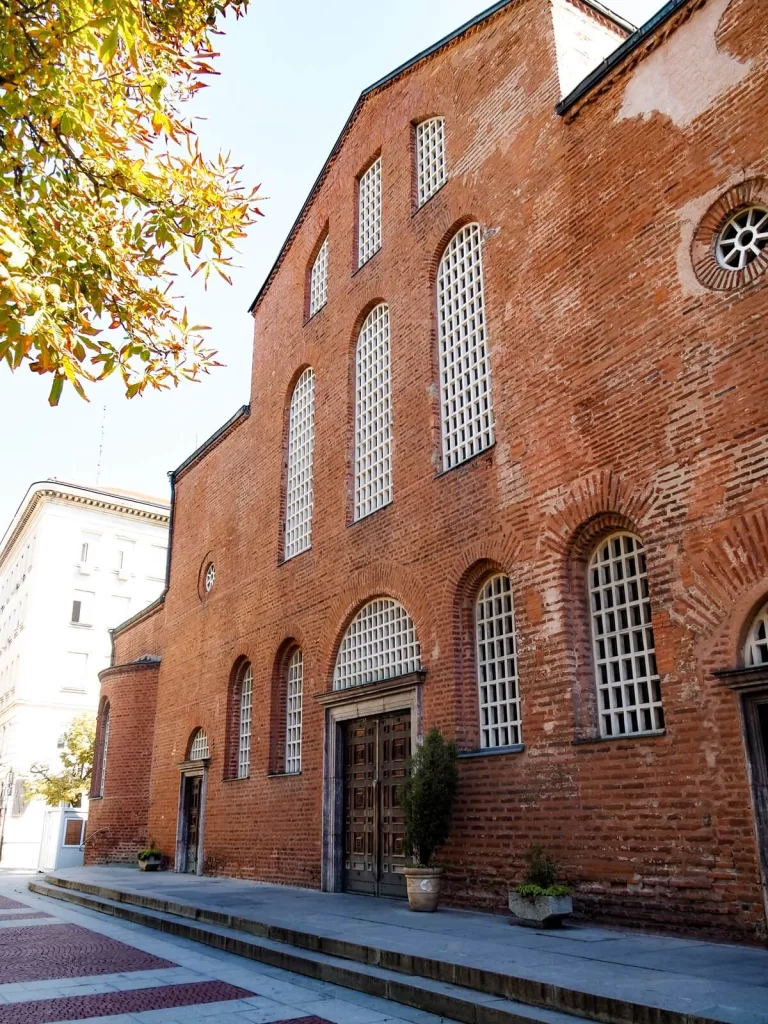
Saint Sofia Church
Located just across from the cathedral is the Saint Sofia Church, one of the oldest churches in the city. Interestingly, the city is named after this church.
The earliest church built here dates back to the 4th century. As you would imagine, there have been several churches built and destroyed on this exact spot in the years since.
The most recent one was constructed in the 6th century and is believed to be the 5th structure on the site. It was built during the same period as the Hagia Sophia of Constantinople that you can visit in Istanbul. During the Ottoman rule, it was converted into a mosque, before being re-established as a church again much later.
You can go inside the church for free but we recommend paying the small fee to visit the section underneath it. There’s a necropolis filled with ancient tombs, stunning mosaics and the ruins of the older churches that archeologists have excavated. It was surprisingly bigger than we expected. Just note that you need to pay extra if you want to take photos.
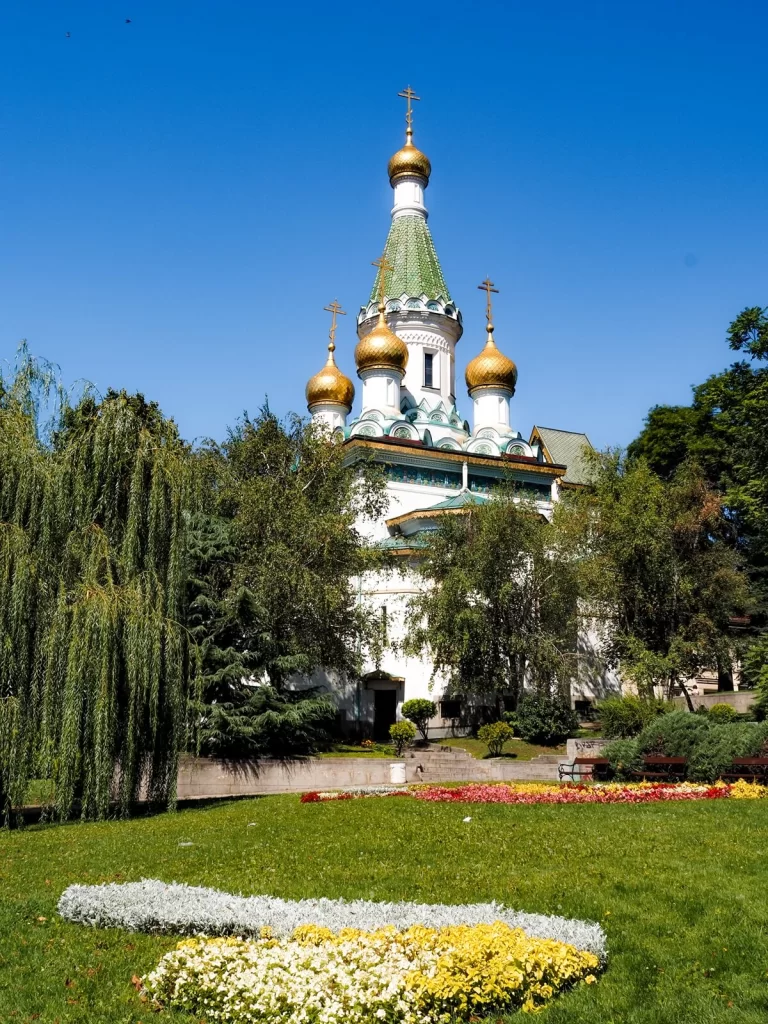

St. Nicholas Church (The Russian Church)
Located only a short walk from the Cathedral is the Russian Church, officially called the Church of St. Nicholas the Miracle-Maker. It was built in 1914 in a Russian revival style, similar to many 16th century Russian churches. The green and white church has five domes made of gold, making it one of the most beautiful churches in Sofia.
You can pop inside to check out its interior, but the exterior is definitely more impressive in our opinion.
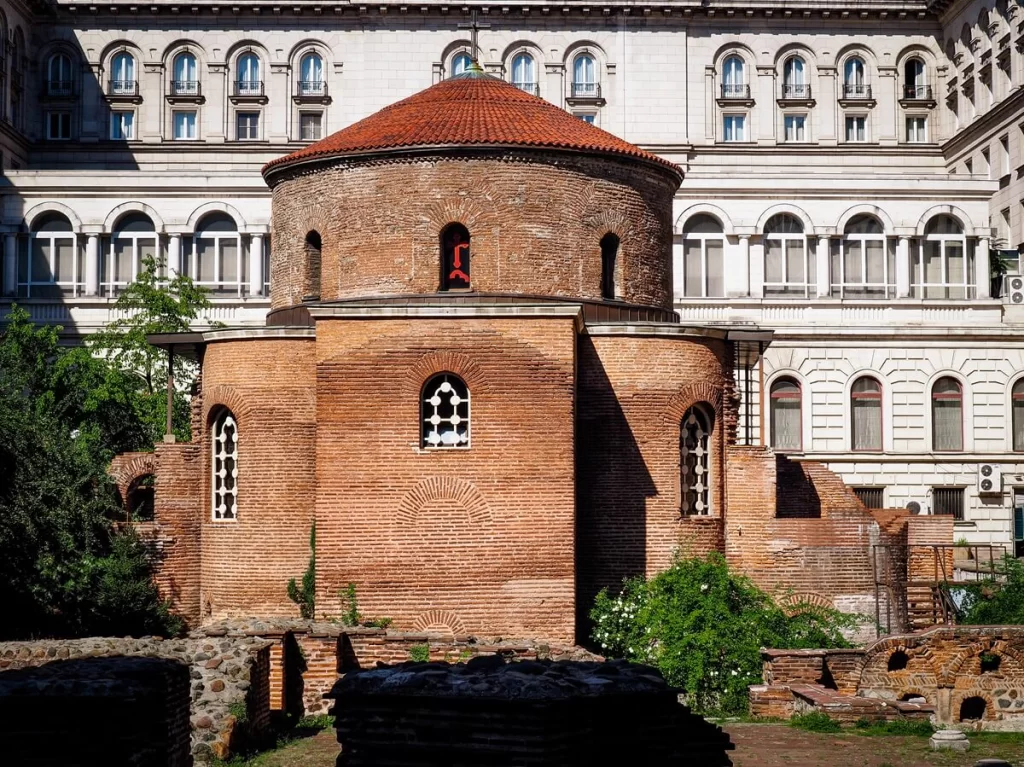
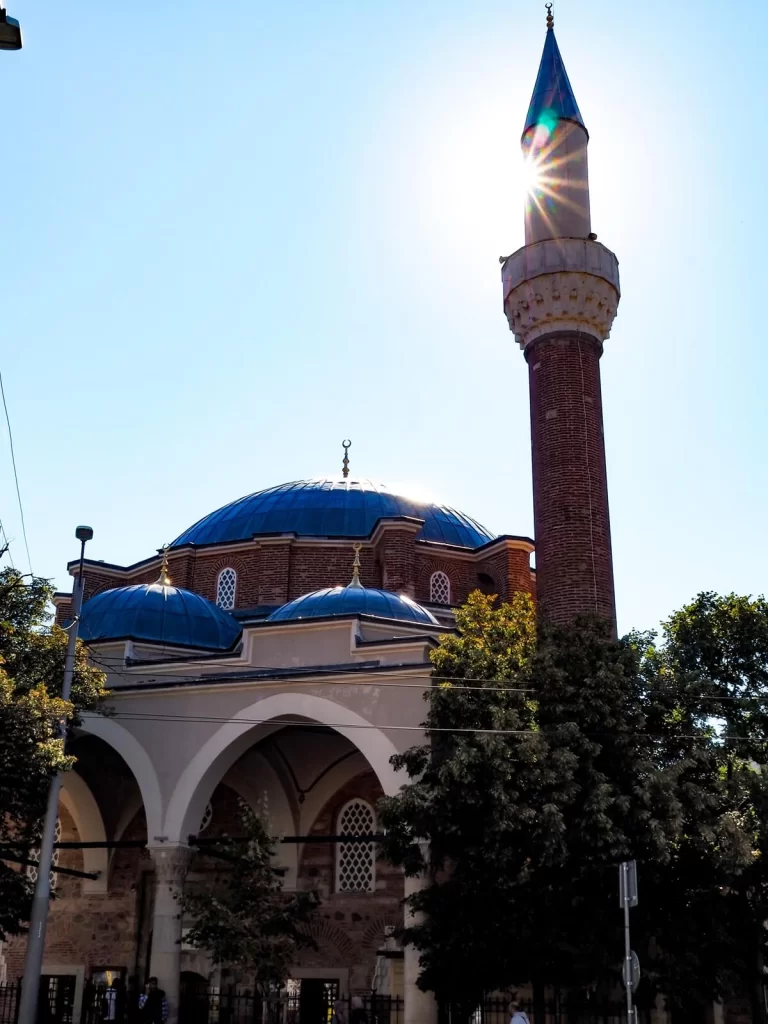
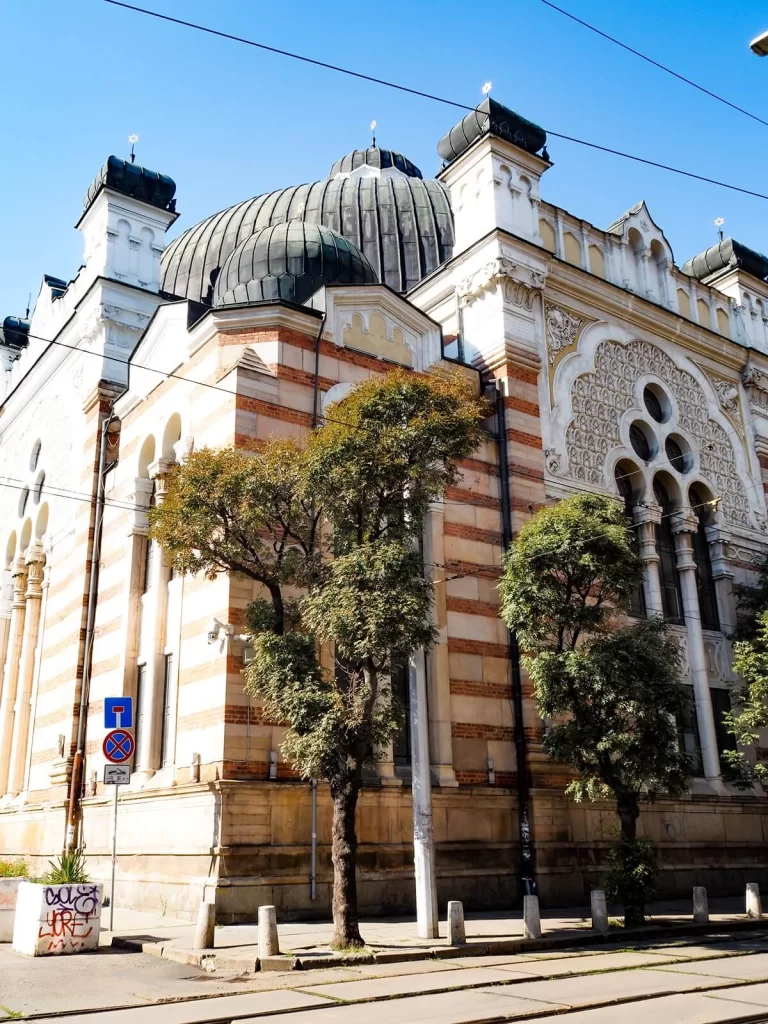
Rotunda of St. George
You cannot miss visiting the oldest church in Sofia during your 2 days in the city. Located in the courtyard of the Presidency, it was built in the 4th century by the Romans. You can walk around it and take a look inside, where you can see some beautiful medieval frescos.
Banya Bashi Mosque
Located across from the Regional History Museum is the Banya Bashi Mosque. This mosque was built in the 16th century during the Ottoman rule. It was designed by Mimar Sinan, who also designed the popular Blue Mosque in IstanbuI.
Banya Bashi is currently the only functioning mosque in Sofia. Whilst the exterior isn’t as eye-catching as some other religious buildings in Sofia, the interior is really beautiful. You can visit inside outside of prayer times. Make sure to dress modestly and, if you’re a women, cover your hair with a scarf before entering.
The Synagogue of Sofia
Another important religious building to check out in Sofia is the Synagogue. For over a century it’s been a symbol of the Bulgarian Jewish community. It is also the second largest Sephardic Synagogue in Europe.
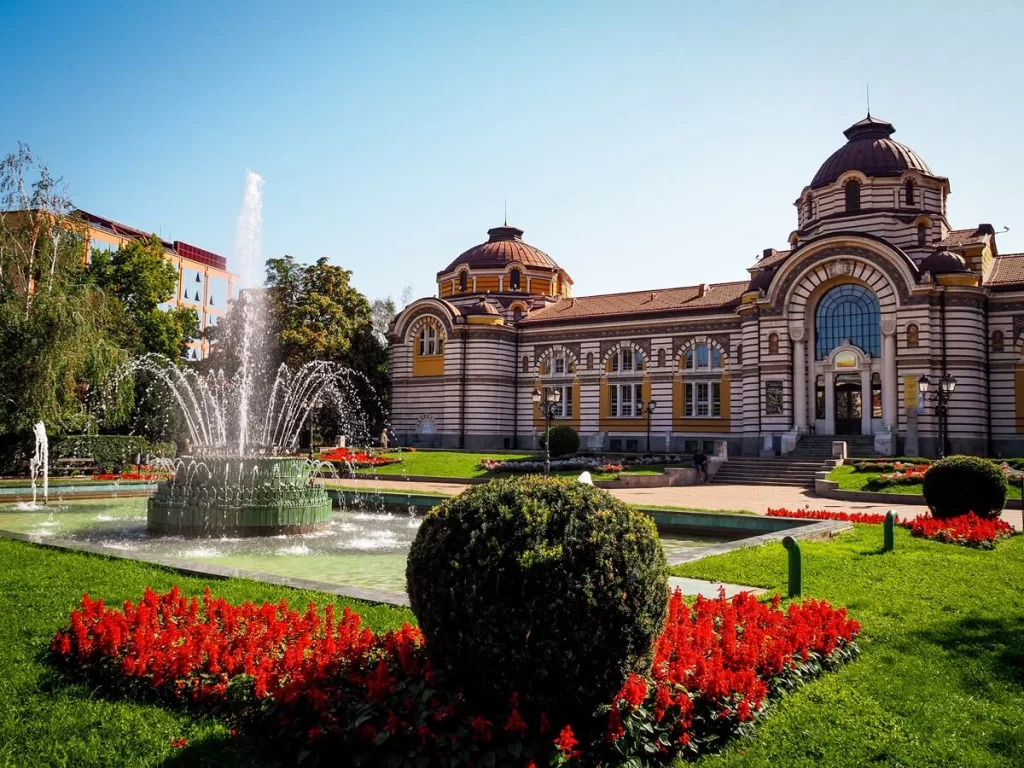
2. Check Out Sofia’s Stunning Architectural Buildings
Sofia’s appearance has been influenced by many different architectural styles over the years. Below are some of the most iconic buildings that we think it would be a shame not to see during your 2 days in Sofia.
Top Tip. You can sign up for a Communist walking tour if you’d like to learn more about the communist history of Sofia.
Central Mineral Baths
One of Sofia’s most iconic buildings has to be the Central Mineral Baths. If you didn’t know, the city is located above mineral hot springs. This colourful Neo-Byzantine building opened as a public bath in 1911. It operated as a public bath up until 1986 but then it had to be closed down due to poor conditions. Today, it’s home to the Regional History Museum.
Whilst you can’t soak in the thermal baths any longer, there are a few fountains where you can fill up your water bottle with some mineral water.
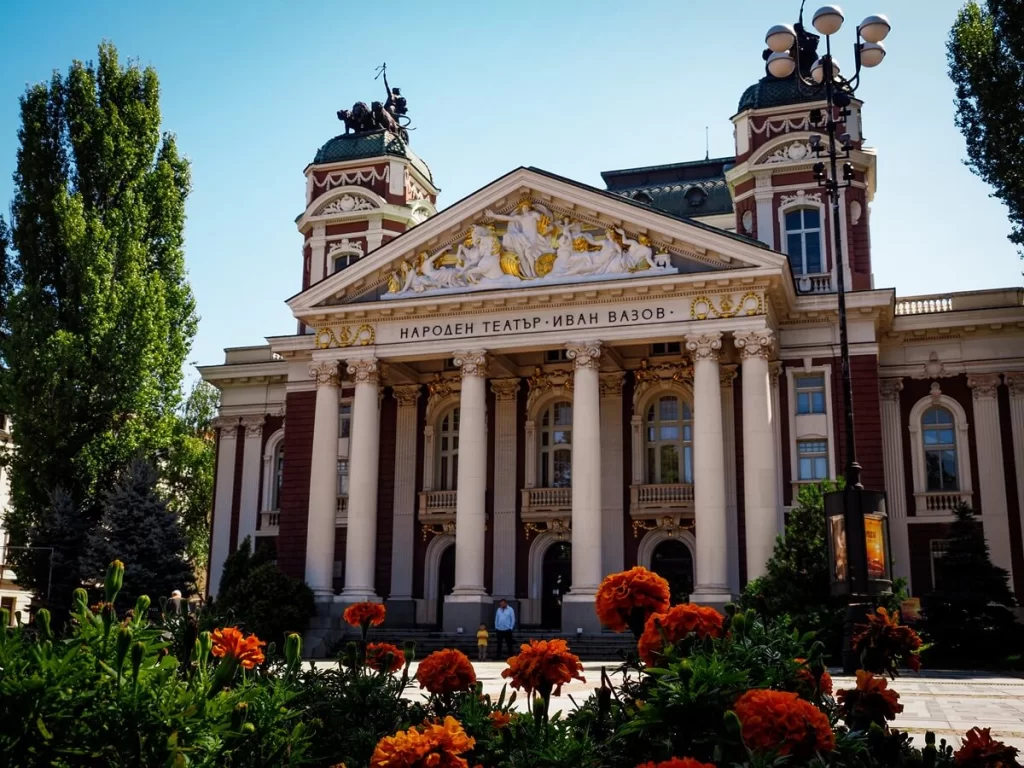
Ivan Vazov National Theater
If you take a short walk to the south from the Russian Church, you can admire another stunning building, the Ivan Vazov National Theater. Built in 1906, it is the oldest and most authoritative theatre in Bulgaria. The building has undergone a few renovations over the years after it was damaged in a huge fire back in 1923, and again during World War II.
You can always watch a performance here if you wish, but it might be a bit of a challenge to understand if you don’t speak Bulgarian.
Right across from the theater is a lovely park (the City Garden) where you can take a quick stroll, or just sit on one of the benches and give your legs a little rest.

National Palace of Culture (NDK)
The National Palace of Culture (NDK) is another iconic landmark in Sofia. Built in 1981 to celebrate the 1300th anniversary of the first Bulgarian State, it isn’t the most beautiful building in Sofia, but one of the largest examples of Communist architecture.
It still functions as a conference centre, and they hold regular concerts here as well as the Sofia International Film Festival. The NDK is actually the largest building of its kind in this part of Europe.

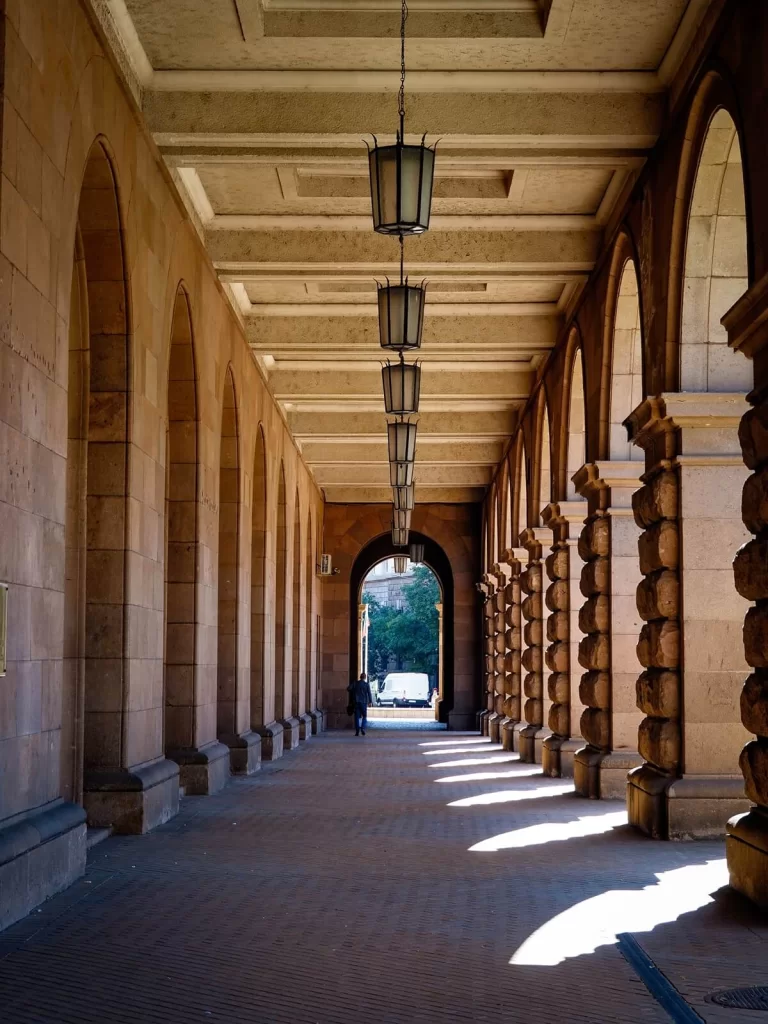
The Largo of Serdika
The Largo is an architectural complex located near the Serdika metro station. It’s made up of three buildings all built in a typical socialist style. Probably the most interesting building here is the National Assembly of Bulgaria. It served as the headquarters of the Bulgarian Communist Party and used to have a big red star on top of it, which is now in the Museum of Socialist Art.
Whilst you’re there, don’t forget to look at what’s underneath you! It seems like finding Roman ruins in Sofia is pretty easy. All you need to do is a bit of digging for a new hotel or metro. Today, there are plenty of places where you can just walk past some ancient Roman ruins like at the Largo.
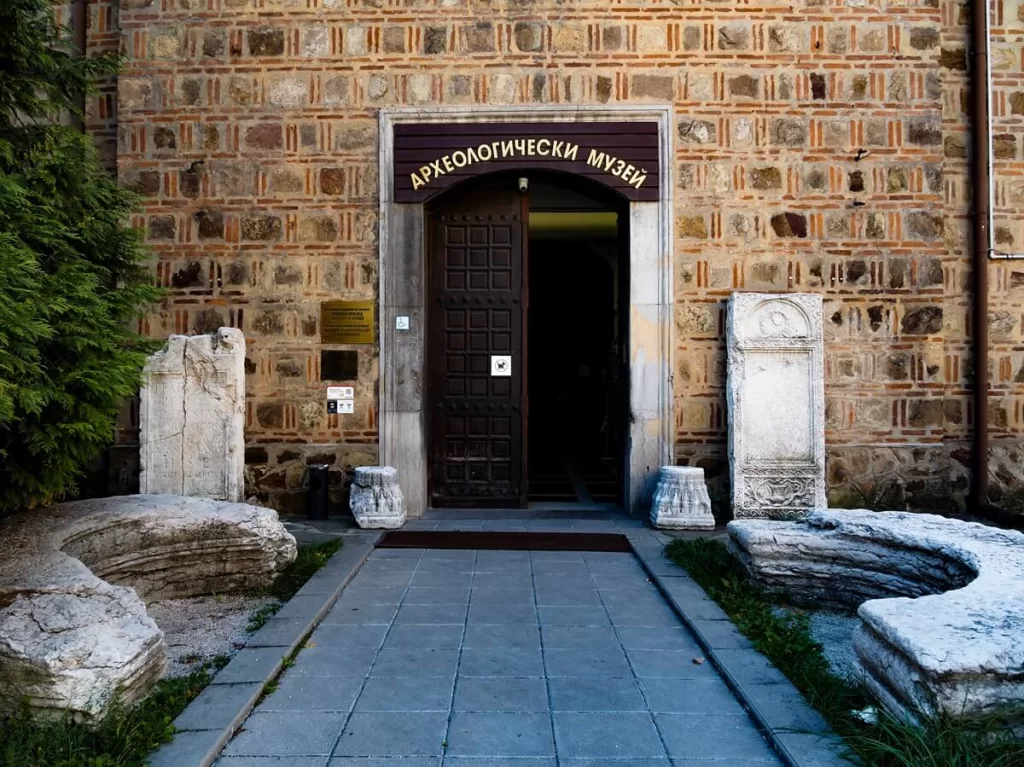
3. Visit the Best Museums in Sofia
Sofia has plenty of interesting museums you should consider adding to your 2 day itinerary. Below we’ve listed a few different ones that you could visit depending on your interests. Please note that most museums will have an entry fee.
- National Archaeological Museum is located inside a former Ottoman mosque. It houses one of the oldest and largest archeological collections in Southeastern Europe, dating all the way back to prehistoric times.
- National Museum of Military History holds a huge collection of different military objects such as weapons and uniforms.
- National Museum of Natural History is the first, and also the richest, natural history museum in the Balkans.
- Ethnographic Museum is housed inside the former Royal Palace. Here you can learn about Bulgarian traditions and ways of life.
- National Art Gallery is also located within the former Royal Palace. It is home to a massive collection of Bulgarian art.
- Earth and People National Museum is one of the largest mineralogical museums in the world, located behind the National Palace of Culture.
- National History Museum is located further outside of the city centre. Once the former residence of the last communist leader of Bulgaria, today it houses a large number of historical objects.
- Museum of Socialist Art is another museum that’s situated outside the city centre. It houses a lot of socialist statues that used to stand across Sofia, such as the giant red star and a statue of Lenin.
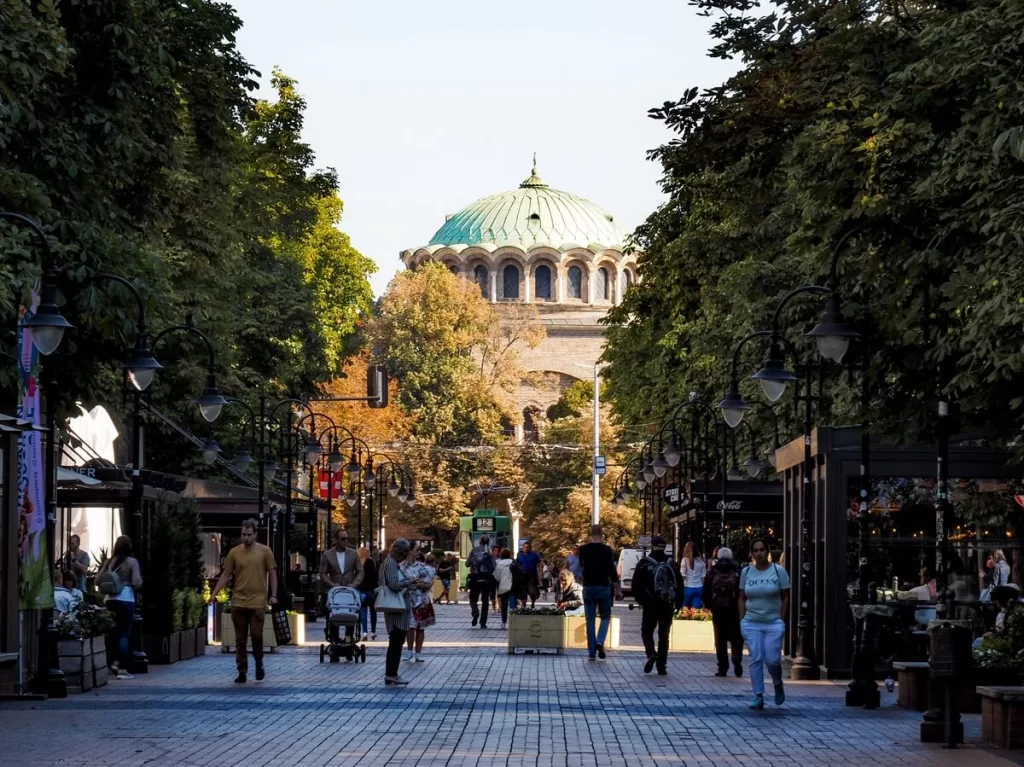
4. Other Fun Things to Do in Sofia in 2 Days
Stroll Down Vitosha Boulevard
Vitosha Boulevard is the largest pedestrian-friendly street in Sofia. It has a ton of trendy cafes and restaurants, as well as souvenir shops and other main-stream shops like those you’ll find in most major cities.
Whether you want to spend some time browsing the stores, or simply sit at one of the cafe’s outdoor seating area’s, then definitely head down Vitosha Boulevard.
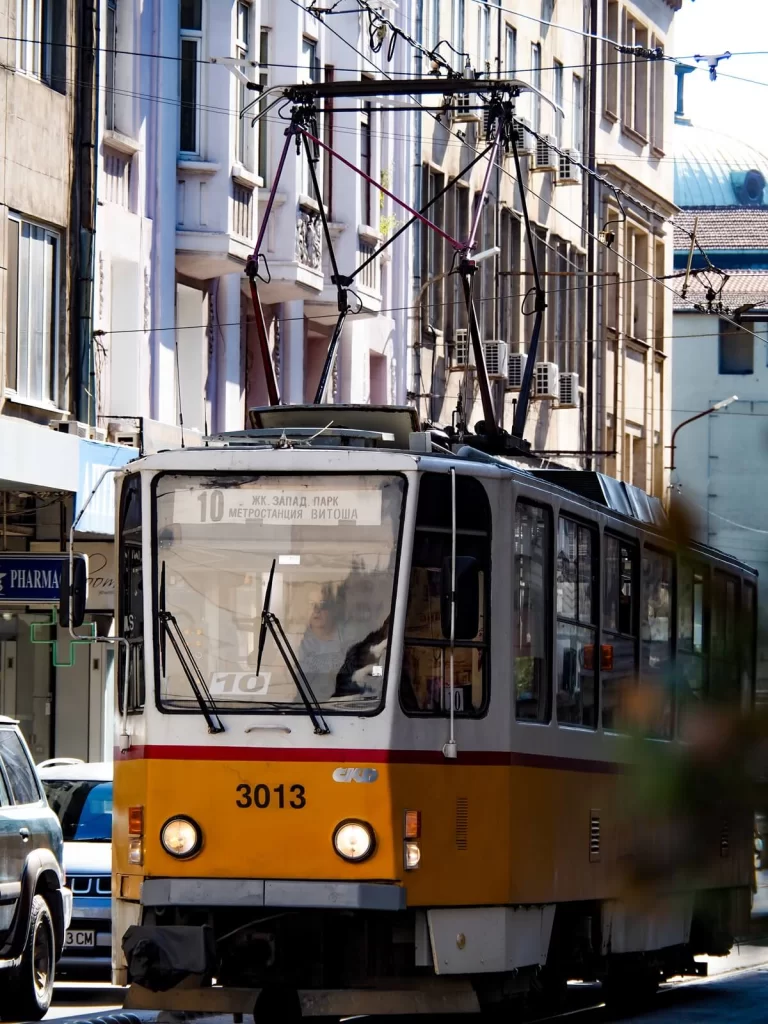
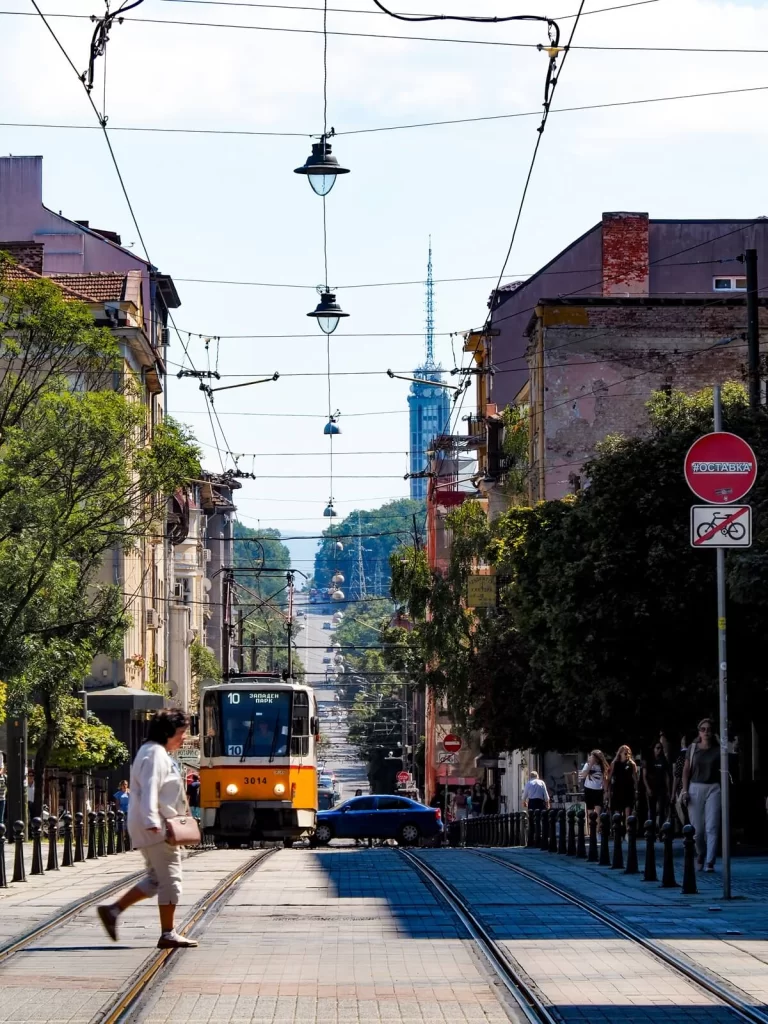
Check Out the Old Trams on the Streets of Sofia
You’ll quickly notice that you can travel around the city using the metro, trams and buses at an affordable price.
Sofia’s tram network is definitely an important part of the city’s public transport system. The first six tram lines opened in 1901, so people have been using this mode of transport for quite some time.
Whilst they’re constantly introducing more modern trams, there are still quite a few old school ones you’ll be able to spot around the city. We loved the yellow ones, but also saw plenty of green ones. If you enjoy urban photography, you will have a lot of fun snapping a few tram photos across Sofia.
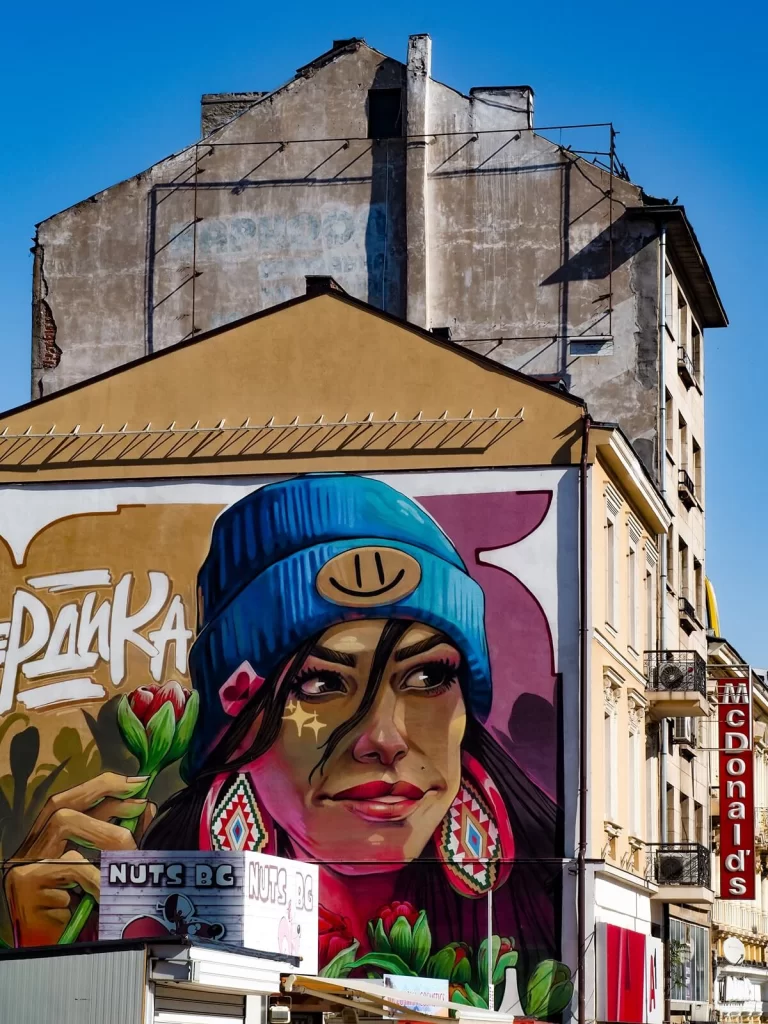
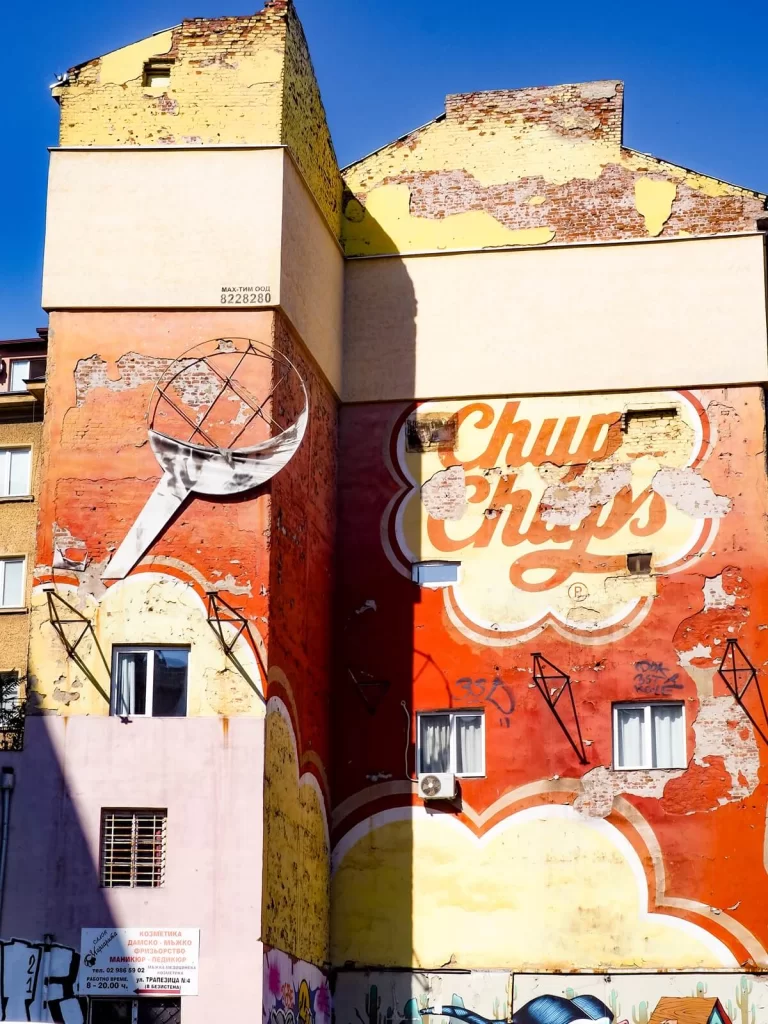
Check Out Sofia’s Street Art
Okay, people definitely don’t come to Sofia for its street art scene. When compared to other cities in Europe like Berlin or London, not to mention countries like Colombia in South America, Sofia’s street art isn’t as prominent.
Currently, there isn’t a particular street or district where you’ll find a large concentration of the murals. However, there are definitely some cool ones scattered around and outside the city centre, so you’ll likely spot a few when wandering around.
As always, if you’re interested in learning more about the meaning behind these murals then we recommend signing up for a dedicated street art tour during your 2 days in Sofia.
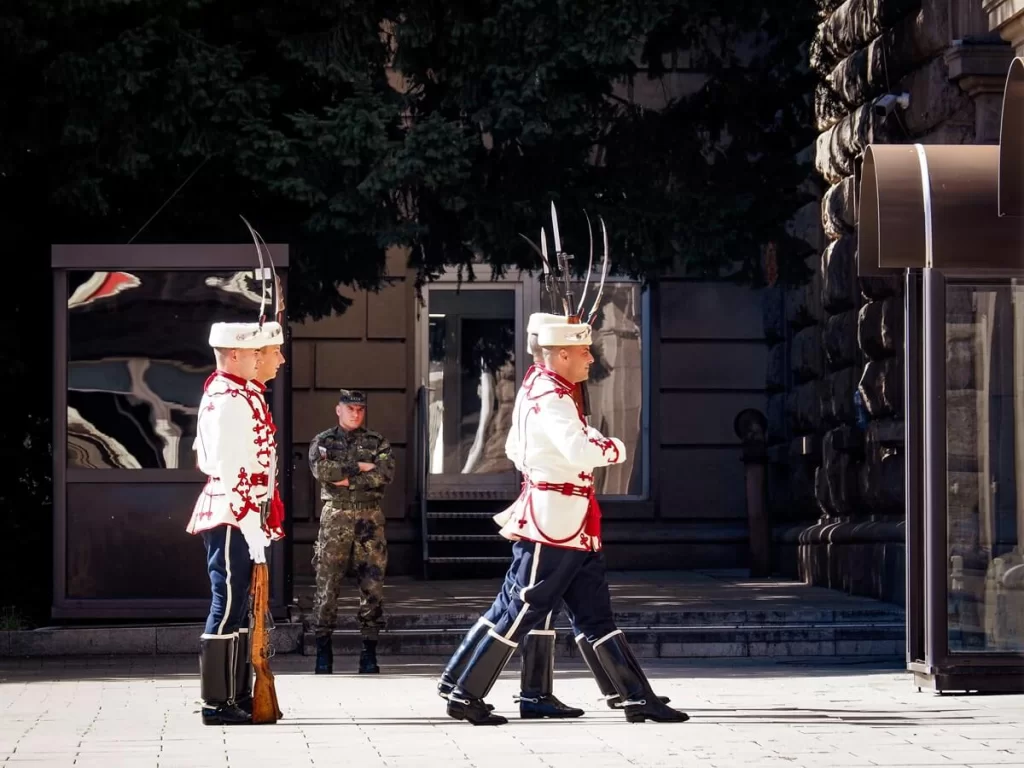
See the Changing of the Guard in Front of the President’s Office
A few minutes before every hour through the day, you can witness the changing of the guard in Sofia. It takes place in front of the President’s Office, which is located between the Archaeological Museum and the Rotunda of St. George.
Although it probably won’t be the most exciting changing of the guard you’ll experience, we think it’s still a cool activity to witness if you’re already in the area.
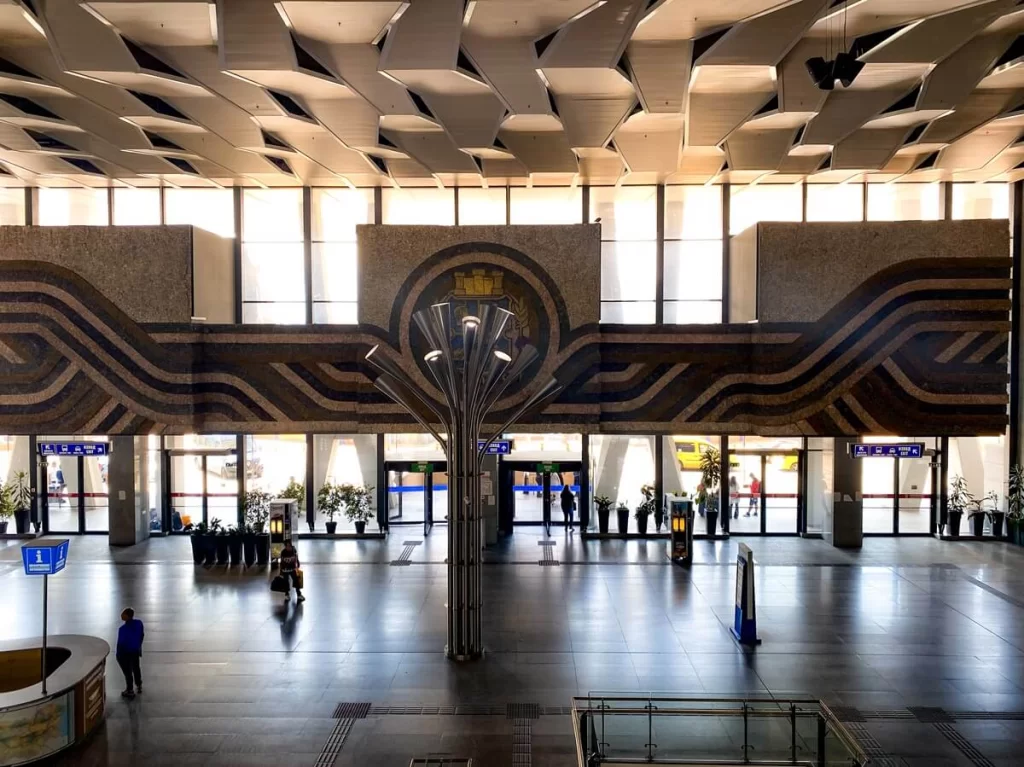
How to Get to Sofia, Bulgaria
There are a few ways you can get to Sofia.
By Plane. Sofia International Airport (SOF) offers direct flights between many major European cities and a few countries in the Middle East. The airport is the largest and busiest airport in Bulgaria. Once you’ve arrived, you can get to the city centre in a few ways.
You can take the metro (M4) from Terminal 2 to Serdika, a main transport hub. Or, you can take either Bus 84 or 184 into the city centre. If you’re arriving during unsociable hours, then you’ll need to take a taxi or a pre-booked transfer. Alternatively, if you’re in Bulgaria for longer, you can pick up a hire car at the airport too.
Find Flights to Sofia✈️
By Bus. If you’re visiting from other European countries, you can also take a bus to Sofia. There are direct Flixbus services from nearby countries such as Albania (Tirana), Romania (Bucharest), and North Macedonia (Skopje). The bus will drop you off at the Central Bus Station, where you can take a short metro, tram, bus or taxi ride to the centre.
By Train. There are a few trains you can take to get to Sofia. A popular journey is the Sofia-Istanbul Express, a night train running daily between Sofia and Istanbul in Türkiye (Turkey).
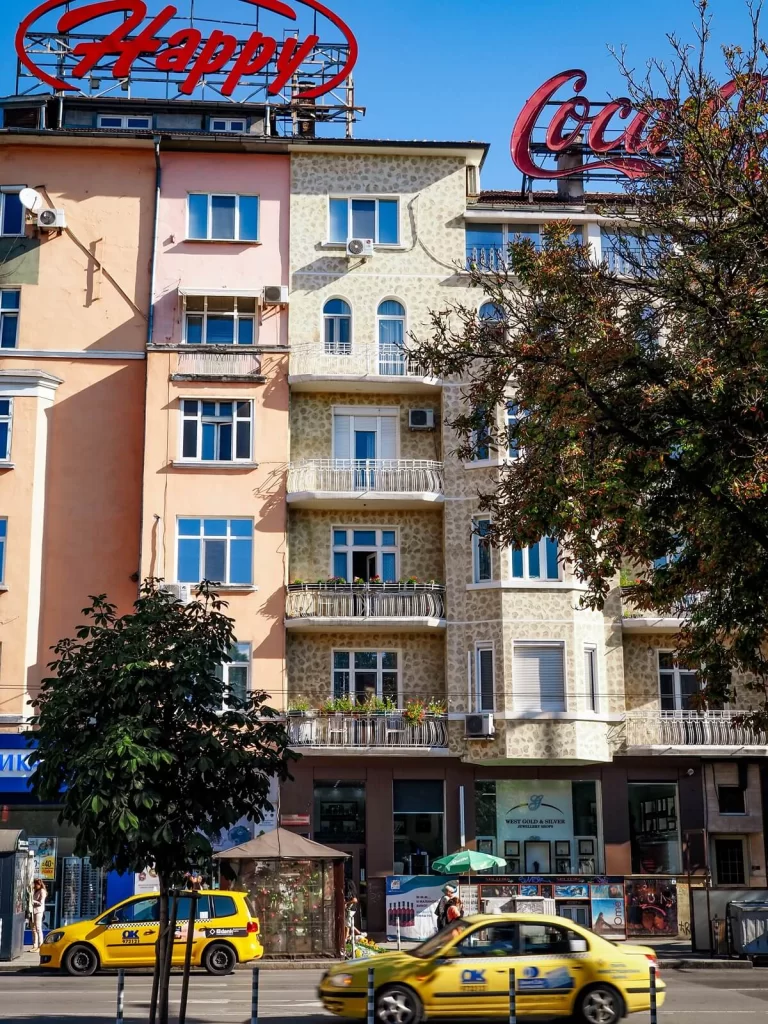
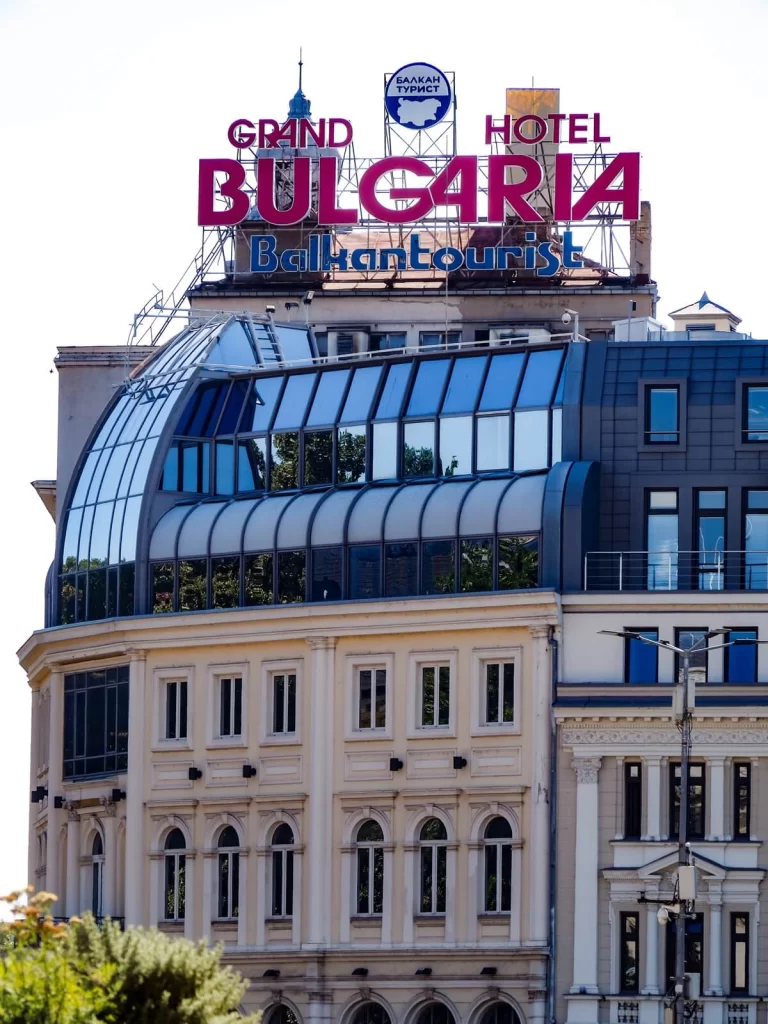
Where to Stay in Sofia, Bulgaria
Depending on your needs and budget, there are plenty of hotels and hostels in the Bulgarian capital.
If you’re only in Sofia for a short weekend break, then we recommend staying around the central area (Centrum). Most attractions are located within this area and you can easily walk between them too. Below are a few hostel and hotel options you can consider:
- Hostel Mostel is known to be a fantastic hostel option in Sofia, located within the city centre not too far from the Central Station.
- Art ‘Otel is in a beautiful building near Vitosha Street and the Palace of Culture.
- R34 Boutique Hotel is a beautifully designed hotel in the city centre, not far from the Ivan Vazov National Theater.
- Central Hotel Sofia offers more of a luxurious stay within the Centrum area, with a ton of amenities.
Check out some more hotel options in Sofia here or some more hostel options here.
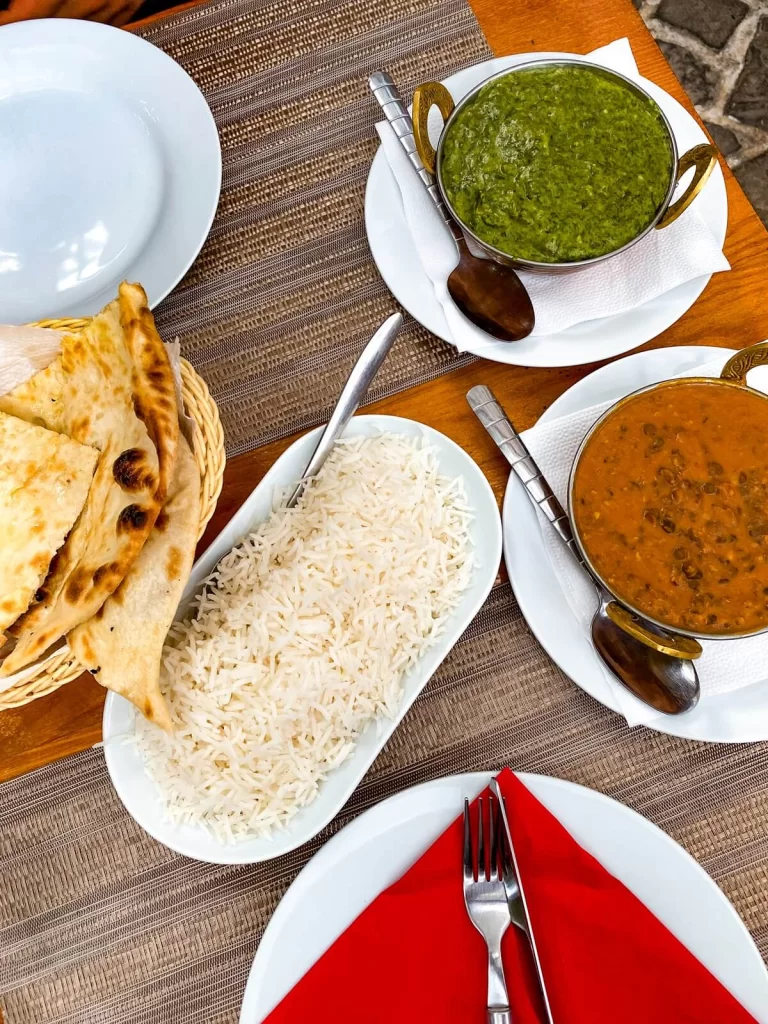
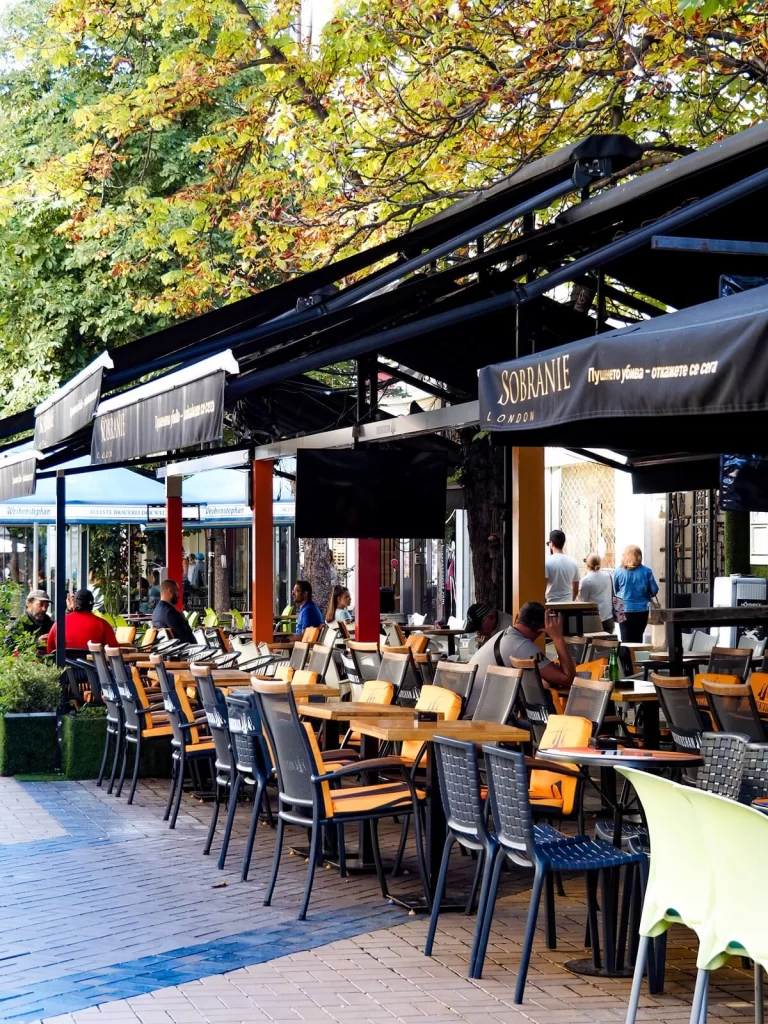
Where and What to Eat in Sofia, Bulgaria
Bulgarian cuisine is amazing. The food in Bulgaria is a mix of Balkan, Turkish and Greek cuisine, so you really have no reason not to try as many traditional dishes as you can during your 2 days in Sofia. Below we’ve listed a few foods on the menu’s to look out for:
- Banitsa is a traditional Bulgarian pastry filled with cheese.
- Tarator is a refreshing cold soup made with fresh cucumbers, walnuts, garlic, Bulgarian yoghurt, dill, herbs and vinegar or lemon.
- Sarmi are cabbage leaves stuffed with a mixture of rice, spices and mince. (Very similar to Hungarian stuffed cabbage rolls).
- Shopska salata is a simple yet popular salad made with chopped cucumbers, tomatoes, onions, peppers, fresh parsley and grated white cheese.
- Moussaka is a well-know dish you may have tried in Greece before. The Bulgarian version is made with potatoes instead of aubergines (eggplants).
We found Sofia to be filled with both trendy and traditional bars, cafes and restaurants so you won’t have trouble finding somewhere to eat during your stay. Here are some of our favorites:
- Hadjidraganov’s Cellars (Serves traditional dishes)
- Sun Moon (Vegetarian restaurant and bakery)
- Satsanga (Vegetarian restaurant)
- Lime Cafe & Cocktails
- Annapurna Nepali & Indian Restaurant
Final Thoughts on Spending 2 Days in Sofia, Bulgaria
We stopped in Sofia for 2 days because it was the best place to get to Istanbul from without flying. Whilst we didn’t have high expectations for the city, we were pleasantly surprised by it. We really enjoyed walking around its streets and seeing its main attractions, which there turned out to be a lot more of than we initially thought.
Have you ever been to Sofia before? If so, how much time did you spend in the city and what was your favourite thing to do there? If not, would you add the Bulgarian capital to your bucket list? Let us know in the comments below.
Now, let your adventure begin,

Our Top Travel Resources
Accommodation: For hotels we always use Booking.com and Hostelworld for hostels. We also book longer stays on Airbnb or Vrbo.
Flights: To find the best flight prices we always check Skyscanner, Google Flights or WayAway. Then we also check the airlines’ websites too for comparison.
Car Rentals: We use Discover Cars when we want to rent a car as it compares local, national and international companies.
Activities: If we book organised tours we always check either GetYourGuide or Viator.
Foreign Currency: Whenever we can we prefer to pay in local currency and for that we always use our Wise card. We can easily withdraw money from the ATM or pay by card at most shops and restaurants.
Travel Insurance: We never go anywhere without travel insurance. You never know what will happen on your trip, so good travel insurance like SafetyWing can protect you in case of injury, illness, theft and cancellations.
eSIM and VPN: To get data abroad we use Airalo which is an app that allows you to download a prepaid eSIM to your phone in over 190 countries. Make sure to have a VPN to avoid hackers accessing your personal data when using public WIFI. We use Surfshark which is the only VPN that offers one account on unlimited devices.

